Summary
- The Colosseum Had Its Gory Days
- The Romans Loved Water
- It Took 150 Years to Build St Peter’s Basilica
- Ancient Rome Had High-Rise Buildings and a Mall
- The Pantheon Is a Giant Sundial
- You Could Get Take-Out in Ancient Rome
- Cats Rule the Roost in Rome
- All Roads Did Lead to Rome
- The Trevi Fountain Makes Wishes Come True
Fun Facts About Rome, Italy
Rome is one of the world’s oldest cities, with a history that dates back to 753 BC. This ancient city, older than Italy itself, boasts a rich cultural heritage and an impressive array of historical sites. If you’re interested in visiting one of Italy’s prime destinations but are unsure where to start, these facts about Rome will inspire your travel plans.
1. The Colosseum Had Its Gory Days
The Colosseum, a remarkable symbol of Roman engineering, was infamous for hosting gladiatorial games and other brutal spectacles. Over 500,000 people and a million animals are estimated to have lost their lives in these events before they ceased in 435 AD. Built by Emperor Vespasian between 72 and 80 AD, this architectural marvel could seat 50,000 spectators and included numerous features such as trap doors and underground passages.
Today, the Colosseum attracts over 6 million visitors annually, making it one of the top attractions in Rome despite only a third of its structure remaining intact. It remains the largest amphitheater in the world, underscoring its historical significance.
2. The Romans Loved Water
Rome’s commitment to water management dates back over 2,000 years. The Romans ingeniously constructed aqueducts and canals to supply water throughout the city, creating stunning fountains that showcase their engineering prowess. With over 2,000 functional fountains, Rome holds the record as the city with the most fountains worldwide.
The wealthy had private water systems installed in their homes, while the general populace enjoyed public baths, which were essential for hygiene and socialization. Some still operate today, allowing visitors to experience Roman bathing traditions at places like QC Terme and Aqua Madre.
3. It Took 150 Years to Build St Peter’s Basilica
Located in Vatican City, St Peter’s Basilica is a must-see for anyone visiting Rome. It stands over the burial site of St Peter the Apostle. Construction began in 1506 under Pope Julius II and wasn’t fully completed until 1626. To truly appreciate this architectural gem, visitors should explore its magnificent interior, dominated by Michelangelo’s awe-inspiring dome.
4. Ancient Rome Had High-Rise Buildings and a Mall
While grand villas and temples are iconic representations of Rome, the majority of the population lived in multi-story apartments that often lacked basic amenities. Additionally, in 100 AD, Trajan’s Market was established as the first covered shopping center, featuring shops, administrative buildings, and communal spaces, solidifying Rome’s role as a commercial hub.
5. The Pantheon Is a Giant Sundial
As Rome’s best-preserved ancient building, the Pantheon offers significant insights into Roman architecture and religious practices. It features the largest unsupported dome globally and contains a fascinating alignment with the sun. Each year on April 21, at midday, sunlight streams through the oculus, marking the founding of the city and providing a mesmerizing sight for visitors.
6. You Could Get Take-Out in Ancient Rome
While the elite indulged in lavish feasts, most residents had limited cooking facilities and relied on thermopolia to purchase meals. These snack bars served hot food throughout the city, reflecting the daily life of ordinary Romans. Traditional dishes, such as Pizza Romana, continue to evoke the flavors of ancient Rome today.
7. Cats Rule the Roost in Rome
Cats hold a special place in the fabric of Roman life. Legislation passed in 1991 protects feral cats living in urban areas, making it illegal to relocate or harm them. The Largo di Torre Argentina is a famous spot where over 250 feral cats reside among ancient ruins, attracting cat lovers and history enthusiasts alike.
8. All Roads Did Lead to Rome
The Romans built an extensive road network spanning over 53,000 miles, facilitating efficient transport and military movement throughout their empire. This system of roads was crucial for maintaining control over conquered territories and remains some of the most enduring aspects of Roman history. Visitors can still explore parts of this ancient infrastructure, notably the Appian Way.
9. The Trevi Fountain Makes Wishes Come True
The iconic Trevi Fountain, renowned for its stunning artistry, attracts millions of visitors each year. It’s said that tossing a coin over your left shoulder into the fountain guarantees a return to Rome. This tradition transformed the fountain into a charitable source, with collected coins donated to help the city’s less fortunate residents.
Discover More Facts About Rome
Rome is undeniably a fascinating destination, rich in history and culture. To conclude, here are some quick facts about the city:
- Rome is the capital city of Italy.
- The population stands at approximately 4.3 million.
- It is the third most populous city in the European Union.
- Rome is the most visited city in Italy.
- Greek and Latin were official languages during the Roman Empire.
- Vatican City, the world’s smallest country, is a sovereign state within Rome.




